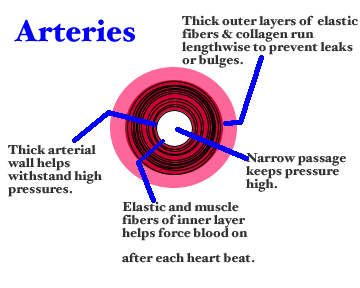Blood Vessels
Three types of blood vessels may be found in the
circulatory system. These are the
a) arteries, which carry blood from the heart
to either the lungs or body tissues,
b) the capillaries which are minute vessels which
deliver nutrients, water, and oxygen to the body cells and pick up cellular
wastes,
c) and the veins which transport blood back to
the heart.
In most cases, arteries are delivering oxygenated
blood and nutrients to the body tissues, while veins transport deoxygenated
blood & cellular wastes back to the heart. However, this does not always
hold true, as the pulmonary arteries transport deoxygenated blood from the heart
to the lungs, and the pulmonary veins transport oxygenated blood back to the
heart from the lungs.
The structure of arteries, capillaries, and veins
is reflected in the position as well as their function within the circulatory
system. These differences in structure and function are illustrated in the diagrams
below.



Slichter



